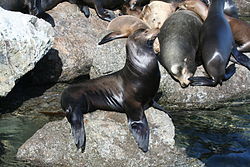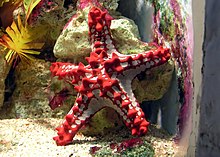Squid are cephalopods of the order Teuthida, which comprises around 300 species. Like all other cephalopods, squid have a distinct head, bilateral symmetry, a mantle, and arms. Squid, like cuttlefish, have eight arms arranged in pairs and two, usually longer, tentacles. Squid are strong swimmers and certain species can "fly" for short distances out of the water.
Modification and ancestral forms
Squid have differentiated from their ancestral molluscs such that the body plan has been condensed antero-posteriorly and extended dorso-ventrally. What before may have been the foot of the ancestor is modified into a complex set of tentacles and highly developed sense organs, including advanced eyes similar to those of vertebrates.
The ancestral shell has been lost, with only an internal gladius, or pen, remaining. The pen is a feather-shaped internal structure that supports the squid's mantle and serves as a site for muscle attachment. It is made of a chitin-like material.
Anatomy
The main body mass is enclosed in the mantle, which has a swimming fin along each side. These fins, unlike in other marine organisms, are not the main source of locomotion in most species.
The skin is covered in chromatophores, which enable the squid to change color to suit its surroundings, making it practically invisible. The underside is also almost always lighter than the topside, to provide camouflage from both prey and predator.
Under the body are openings to the mantle cavity, which contains the gills (ctenidia) and openings to the excretory and reproductive systems. At the front of the mantle cavity lies the siphon, which the squid uses for locomotion via precise jet propulsion. In this form of locomotion, water is sucked into the mantle cavity and expelled out of the siphon in a fast, strong jet. The direction of the siphon can be changed, to suit the direction of travel.
Inside the mantle cavity, beyond the siphon, lies the visceral mass, which is covered by a thin, membranous epidermis. Under this are all the major internal organs.


